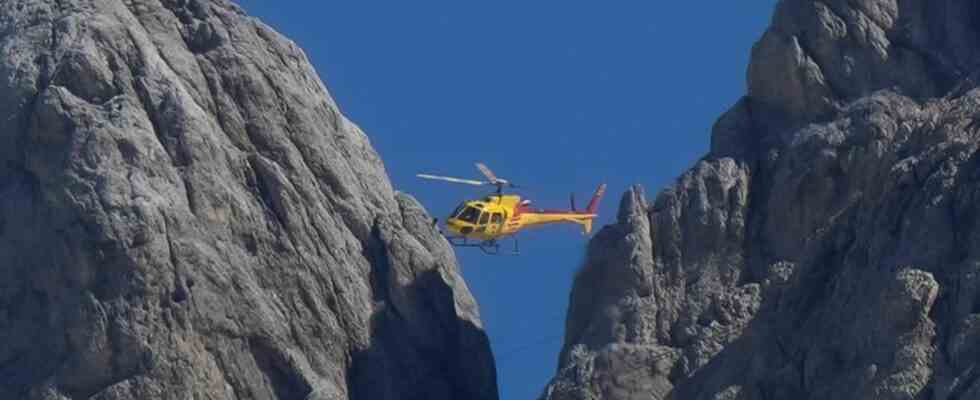After the fatal glacier rupture, the search for more dead people in the Dolomites continues under difficult conditions. A seventh victim was discovered.
An eerie silence descends on the Marmolada. The day after the glacier catastrophe with at least seven dead and many missing, only a few helicopters fly to the flank of the mighty Dolomite massif.
An approaching thunderstorm darkens the sky, the last search parties with their drones withdraw for the time being. The risk of further glacier or rock falls is too great. There’s thunder. Rain falls on the mountain in northern Italy and the avalanche cone of ice, snow and stones, under which more than a dozen people are feared dead.
Two Germans were also caught by the avalanche on Sunday, which thundered down into the valley at a good 3,000 meters above sea level after the glacier broke. That said a spokeswoman for the Foreign Office of the German Press Agency. The two are injured and are being treated in a hospital in Belluno, south-east of the scene of the accident, according to the clinic there. Accordingly, it is a 67-year-old man and a 58-year-old woman. Both would be closely monitored. In the afternoon, 14 mountaineers were still officially missing. Seven dead were recovered; in addition to the two Germans, six others were injured.
Draghi: Italy “cries for the victims”
On Monday there was a camper with a Bavarian license plate in the parking lot below the Marmolada. According to police officers, the car was already parked there on Sunday and was not driven away. The parking ticket behind the windshield expired at 9:30 a.m. It was unclear whether it was the car of the injured Germans.
“Today Italy is crying for the victims,” said a visibly emotional Prime Minister Mario Draghi during a visit to Canazei at the foot of the Marmolada. He also thanked the emergency services and expressed his condolences to the families of the dead, missing and injured. The head of government also met relatives of the victims on site. A site visit was very important, underlined Draghi.
Emergency services fear more glacier fractures
The search and rescue work on the more than 3340 meter high mountain on the border of the Trentino-Alto Adige and Veneto regions had to be interrupted due to bad weather. In any case, the emergency services no longer sent people directly onto the avalanche cone because they feared that more pieces of the glacier could break away. A chunk of 200 meters wide, 60 meters high and 80 meters deep hangs dangerously over the slope, said the civil defense.
Before they were pulled off the glacier because of the bad weather, the drones located body parts and material such as ropes and backpacks in the morning, said Alex Barattin from the Belluno Mountain Rescue Service.
Virtually no chance of finding survivors
But there is practically no chance of finding survivors under the ice and rubble masses. Rather, according to the rescue teams, identifying the corpses will be difficult given the forces with which the avalanche had caught the people.
It may be weeks or even longer before all the dead are found and recovered. That said Maurizio Dellantonio, the president of the Italian mountain rescue service. He explained that huge amounts of ice and rock had slid into crevasses and crevasses. The rock crevices should be uncovered in the summer, also thanks to the ice melting with the warm temperatures, he hoped.
“But if someone has fallen into crevasses at the top of the mountain, then it will be difficult,” Dellantonio said. “It is currently not possible to dig because the mass of ice has already settled and has become hard. That would only be possible with mechanical equipment, but we can’t bring that up.” The ice is sometimes up to ten meters thick, said the mountain rescuer. That is why locating and recovering the bodies is so difficult.
Disaster also attributed to rising temperatures
Head of state Sergio Mattarella and other politicians expressed their condolences to the victims and bereaved and thanked the helpers. Pope Francis prayed for the dead and injured. “The tragedies we are currently experiencing with climate change must push us to urgently find new human and nature-conscious ways,” demanded the 85-year-old head of the Catholic Church on Twitter.
According to climate experts and glacier researchers, the accident is also due to the rising temperatures. These allow the glaciers to continue to melt and crumble; due to the low precipitation this winter there was no snow, which could have additionally protected the glacier from the sun.
The extreme mountaineer Reinhold Messner also has an explanation for the accident and was not surprised. “The main reason is global warming and climate change. These eat away at the glaciers,” the 77-year-old told dpa. So-called ice towers – called séracs – then form just at the edges of the demolition, “which can be as big as skyscrapers or rows of houses,” explained Messner.
Messner warns: only do tours with a mountain guide
The South Tyrolean, who was the first alpinist to climb all 14 eight-thousanders in the world, knows Séracs from the Himalayas, for example. He warns that tours on ice should only be done with a mountain guide. But even that is no guarantee of security; according to media reports, mountain guides are also among the missing after the Dolomite disaster.
Incidents like the Marmolada “we will see more often,” said Messner. “Today there are a lot more rock and ice falls than there used to be.” Prime Minister Draghi sees a need for action: “The government needs to think about what happened and take action.”
“Global warming comes from the metropolitan areas and cities, from the highways and factories,” said Messner. “But we in the mountains notice it, for 30 years we have been seeing with the naked eye how the glaciers are melting. You don’t have to be a scientist to do that.”

